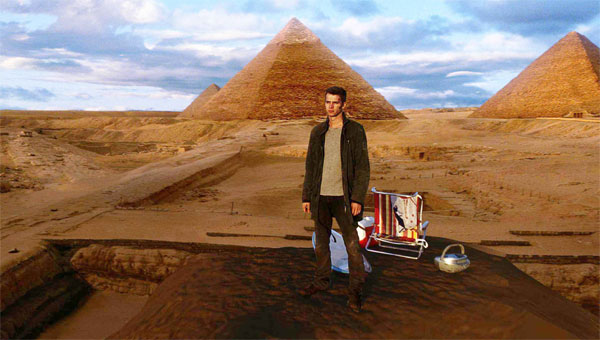Jumper 3D Review

Jumper 3D, or why I’m glad I have an arts degree.
I truly think art can save the world.
Not all art mind you, and in particular not Jumper which let’s be honest was rubbish.
Did you see it the first time it came out?
Blink and you’d have missed it’s release, and even if you managed to catch it in the first place it’s pretty fast with a run time of 88 minutes.
In the bloated age of tent pole super pictures that clock in above two hours, this film feels like an ad.
A brief summery of the 3D plot of Jumper is that it’s Jumper, but with beautiful 3D imagery.
Nothing flashy, just nicely touched up 3D.
For those who don’t know Jumper’s plot though, here it is.
There’s this guy called David, played by Hayden Christensen, who can teleport, a nice party trick he became aware of at fifteen inadvertently teleporting to an aisle of a library instead of dying in an icy river.
Unable to stay at home, and who would once they’d discovered they could teleport, David travels the world robbing banks and living the high life. Though he promises to return the money and leaves IOU’s at the scene of the crime, because Dave really is a good guy after all.
Anyway, one day some Samuel L Jackson shaped guy named Roland shows up, who happens to be a Paladin and sworn enemy of Jumpers because they believe teleporting is against the will of god.
With an enemy hot on his trails, David does the sensible thing and asks his high school sweet heart Millie on a date to Rome.
Chaos follows as Roland tracks David and Millie down, and David has to team up with a fellow Jumper called Griffin in marvel comic-book style to bring down Roland and his team of ruthless paladins and save his one true love.
As I head home, slightly sick having ate a whole pizza pie during the screening, it hits me.
Jumper 3D is brilliant.
It’s a medititive exploration of the somatic body in the digital age, in particular director Doug Liman’s film is an exploration of how digital cinema is changing our relationship to the film medium.
By that, I mean traditional celluloid cinema used cuts – sometimes called jump cuts – in editing; actual cuts to the celluloid that were then stitched to other bits of celluloid that produced a narrative.
Now digital cinema doesn’t need these cuts, as pixels can be seamlessly edited to transport us visually from one scene to the next.
What this means for is that film, as we’ve traditionally understood it, is quickly dying out. Digital isn’t just a new technology being used within the field, it’s a new art form.
Anyway, back to Jumper.
The film revolves around many scenes where the main character teleports, or jumps, to new locations, leaving behind scaring in the air that are actual marks of ripping the fabric of space.
The somatic human body of David is also often physically cut in the film, his body is always lacerated by minor cuts and abrasions, blood drips from his lips.
David is the embodiment of celluloid in this film, and the rest of the cinematic world is the digital.
The world keeps changing, moving, altering, objects appear in places they should not be, world’s are sutured together through digital painting. Whereas the digital presents the world, and by extension the real, as illusionary and fluid.
It’s why the narrative world in especially in Jumper 3D is so beautiful yet haunting, in it’s digitized, painted plane of existence.
And David’s the somatic celluloid, his body trying to retain its relationship to the real but is so subsumed in the digital world as to fragment itself. He’s a man fighting a war the rest of the world is unaware is occurring.
So I think Liman’s Jumper 3D, other formats are available, is actually a meditation on the digital and the demise of celluloid.
At least it could be, which is why I’m glad I have an arts degree.
It usually means I’m able to salvage some meaning from something utterly mindless.
Shelton Lindsay